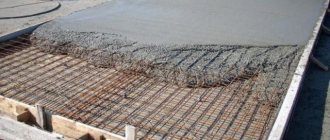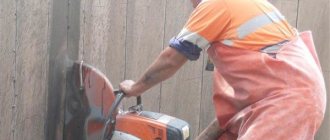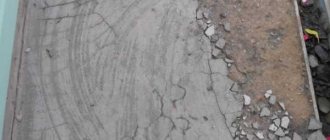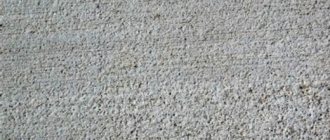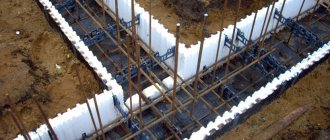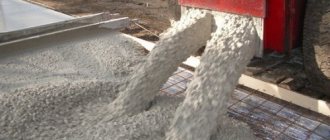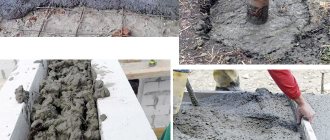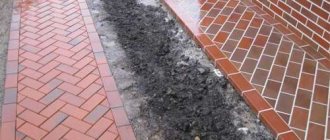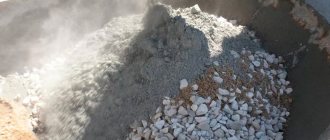Comments:
Rating: 39
Private developers, not being professional builders, often do not understand why concrete cracks when drying.
Often, if prepared and poured incorrectly, concrete cracks and crumbles after drying.
It seems that high-quality components for concrete were used, and the proportions were maintained correctly, and the pouring technology was followed, but cracks still appear in the concrete monolith. So why does this happen and are there ways to avoid it?
Causes of cracks
Cracks in concrete can appear for a variety of reasons. Conventionally, these reasons can be divided into several large groups:
- structural;
- structural;
- influence of external factors.
Structural cracks arise due to miscalculations by designers or due to the introduction of unjustified changes to the design calculations of the structure, such as replacing the M100 grade mortar with a lower grade when pouring it or erecting an additional floor that was not taken into account in the design.
Types of cracks in concrete: a) longitudinal cracks; b) transverse cracks; c) corrosion of concrete and reinforcement; d) buckling of compressed reinforcement bars.
Such cracks are a serious threat to the load-bearing capacity of the structure, even to the point of its destruction. But to eliminate the causes of their occurrence, you need very little: trust only reputable companies to carry out design calculations and do not deviate from these calculations either during concrete pouring or during further construction.
Cracks in concrete can also appear under the influence of external factors: fire, flood, soil movements due to an earthquake or nearby explosions. The reason for their appearance is practically beyond the control of human will, so their prediction is impossible.
Structural cracks are the most common and most diverse group of cracks in concrete. Often the danger of such cracks is underestimated and sufficient measures are not taken to eliminate them, which leads to the concrete monolith losing its strength characteristics and its gradual destruction.
Return to contents
Types of structural cracks
Structural cracks in concrete are the most common and diverse group of concrete cracks. These are actually shrinkage cracks. The reason for their appearance is the natural physical and chemical processes occurring in concrete. They are especially active at the initial stage of maturation of the concrete monolith; then their speed slows down, but the processes themselves do not stop until the concrete has completely matured.
Reasons for the formation of concrete cracks.
In other words, these damages appear in the concrete due to the drying and shrinkage of the concrete mixture after pouring. It is well known that a concrete mixture consists of 4 main components: cement (binder), sand and gravel or crushed stone (fillers) and water. Each of the components plays its own strictly defined role in creating a concrete monolith.
Freshly prepared concrete mortar has a plastic or even liquid consistency. The mixture poured into the mold begins to harden. The further this process goes, the more the cement and water contained in the concrete are reduced in volume. As a result, shrinkage of the poured mixture occurs, and in the body of the forming concrete monolith, due to the compaction of the mass, loads arise that the cement mortar, which has not yet gained sufficient strength, holding together the mixed components of concrete, is simply unable to cope.
As a result, shrinkage cracks are most often a consequence of processes occurring inside the hardening concrete monolith. Conventionally, they are divided into:
- damage from plastic shrinkage;
- temperature-shrinkage damage;
- shrinkage damage from drying out the solution.
It is very important to correctly determine the cause of damage in a concrete monolith, because the method of repair directly depends on this.
Return to contents
Damage from plastic shrinkage
Scheme of crack formation due to shrinkage.
This type of damage usually occurs due to intense loss of moisture from the exposed surface of the laid concrete, resulting in uneven shrinkage and compaction of the concrete mass.
This process occurs at the very beginning of setting of the poured concrete mixture. Due to the evaporation of moisture, the surface of the solution actively loses volume, while the middle and bottom layer of laid concrete remain in their original dimensions. The result of this shrinkage is the appearance on the surface of the concrete mixture of a network of small (the width of a human hair) and shallow cracks.
Phenomena similar to those described occur with concrete during precipitation. When it rains, the surface of the concrete gets wet, and a certain amount of moisture gets inside the monolith. When the rain stops and the sun comes out, the wet surface of the concrete heats up, expanding, and cracks may appear on it.
This type of damage also includes cracks that appear in concrete under the influence of gravity. The reason for the appearance of such cracks is insufficient compaction of the concrete being laid. In this case, the following results: the forces of gravity act on the setting concrete monolith, and if insufficiently compacted areas remain in its body, then the mixture in these areas will continue to compact, breaking the integrity of the concrete monolith.
Return to contents
Temperature-shrinkage damage
Scheme of processes during concrete hardening, formation of structure and formation of properties.
Such deformations occur because the cement used for the binder, in contact with water, enters into a hydration reaction, which results in the release of a large amount of heat and, in accordance with physical laws, an increase in the volume of the solution.
In the mortar being laid, this heating and increase occurs evenly, but in hardening concrete, hydration slows down in hardened areas, and continues with the same force in unhardened areas. This unevenness causes damage to the drying concrete.
The hydration reaction also has the opposite effect, which is no less dangerous for the integrity of the concrete monolith. In the hardening upper layers of the poured concrete mixture, hydration stops and they decrease in volume, while in its deeper layers the process continues and they, accordingly, increase their volume. The result of such exposure to multidirectional forces on the monolith often results in ruptures of the concrete monolith.
Return to contents
Shrinkage damage from drying concrete
This type of damage usually occurs because a concrete monolith that has already set, but has not yet fully matured, continues to decrease in volume.
This is a feature not only of concrete, but also of any cement and adhesive compositions, such as cement screed, plaster, etc.
This is the most common type of shrinkage damage, and preventing the formation of such cracks is a very difficult task. In addition, such temperature damage widens and deepens small cracks in concrete that appeared from the first two types of shrinkage damage.
Return to contents
How to prevent and eliminate cracks in concrete
Components for preparing concrete mixture.
It is clear to any sane person that it is better to prevent a problem from occurring than to eliminate its consequences. All this is completely true for cracks in a concrete monolith. To save yourself from unnecessary work in the future, when preparing a concrete mixture you need to follow a few simple rules.
When kneading the mixture, you need to follow the recipe and strictly observe the proportions between its components. Keep in mind that cracks can appear not only from excess water in the mixture, but also from excess cement in it.
When pouring, the concrete mixture must be compacted as much as possible. This will protect the poured mixture from damage due to the effects of gravity. Also, to prevent the appearance of cracks in the concrete being laid, reinforced belts are installed.
Concrete needs maintenance after pouring. Its main task is to prevent excessively rapid or uneven evaporation of moisture from the body of the poured concrete mixture. To do this, the mixture is covered with a moisture-proof film or burlap, and periodically - after 4-8 hours - its surface is moistened with water until completely set.
Expansion joints in concrete floors.
For large areas of filling, in order to avoid the appearance of cracks from temperature changes, it is necessary to install expansion joints. If necessary, the formwork can be insulated.
If cracks do appear, then you need to carry out work to eliminate them as quickly as possible. Cracks must be repaired with cement mortar based on Portland cement. Moreover, it is advisable to prepare the cement mixture of the same brand as the poured concrete, then the uniformity of the concrete structure will not be compromised.
After sealing the cracks with cement mortar, the treated surface must be thoroughly smoothed with a brush. Then the surface is covered for 2-3 days with plastic film, secured at the edges with strips or bars. The film should be periodically removed to moisten the treated surface with water.
Even the most highly professional builder will not be able to completely avoid the appearance of cracks in concrete; sooner or later they will appear. But their appearance can be delayed for a long time, and the cracks that appear can be repaired quickly and efficiently, preventing the destruction of the concrete monolith. Good luck!
The demand among consumers for both concrete and products is constantly growing. As a result, enterprises are increasing their volumes, and manufacturers are opening new factories and launching production lines. The quality of all products produced by enterprises remains important for manufacturers and their consumers.
Strength ratio table.
Quite often, those who independently carry out construction work on their site, and even professional specialists, wonder why concrete cracks? Is it possible or avoidable and what affects it?
After all, repairs when they have already begun to deteriorate are troublesome and sometimes ineffective. Therefore, it is better to do everything at once with high quality, in compliance with all the rules. The main thing is that the appearance of various deformations on the surface can be avoided, although this is not easy.
Materials for work
As you know, the composition includes: cement, crushed stone, sand and water. In its plastic state or fresh form, concrete has a liquid consistency. After pouring, as the mass hardens, cement and water are reduced in volume. The resulting loads, which appear due to compaction of the mass, are difficult for fresh concrete to withstand due to its low strength.
One of the main factors for high-quality concrete is maintaining the correct proportion of all components included in the composition.
Here it is necessary to take into account not only the state of the solution, but also the conditions under which it is located, namely:
Scheme for preparing the mixture.
- when using the solution in rooms with low temperatures, chemical additives should be added to the mixture to prevent the formation of a frozen crust;
- at elevated temperatures, the solution quickly hardens, its structure changes, and after installation, when dry, it begins to quickly crack;
- To create a good fill, you should take high-quality dry mixtures, avoid drafts, observe the temperature regime and moisten the surface during the entire drying time.
Repair with cords and tapes
If you need to cover up cracks in a swimming pool or water tank, in an underground section of the foundation or on the external walls of a building where high-quality waterproofing is required, then the methods described above will not be enough to ensure the strength of the structure.
To treat the opening in such places, a special composition is usually used. The cost of such repairs is an order of magnitude higher than conventional methods, but in a humid environment it is completely worth it.
These materials ensure complete sealing of the crack, so the coating will last for many years.
Repairs are possible both indoors and outdoors, at any time of the year.
Repairs must begin, as in previous cases, by processing the opening. After all excess has been removed and the surface of the furrow has been cleaned with a vacuum cleaner, the width and depth are measured.
This is done in order to choose the right self-expanding cord for repair.
A cord is placed in the cut, which should lie without coercion, freely.
There should be 20-30 mm left to the bottom and top of the furrow so that the cord will expand further. Whatever type of cord you choose, you cannot force it.
Now polyurethane sealant is applied on top of the cord, the surface of which is smoothed with a spatula. The glue that has come out of the seam is removed with a sponge.
Usually it is written on the packaging which material is preferable for a given type of cord or tape; strictly follow the recommendations.
If you will use this material in relatively dry rooms, where waterproofing serves only for insurance, the finishing can be done using cement mortar.
Today the range of such products is quite wide.
This material consists of polymer resins and modified clay, and also contains bentonite material or its analogue, which binds the surfaces together and seals them.
As for the release form, they are as follows:
- Cord - the material is used for repairing shallow cracks of 30 - 50 mm;
- Tape - the material is placed in cracks 20 - 50 mm wide and up to 150 mm wide;
- Paste - sealant is used to treat small furrows;
- Mats hold together layers of concrete screed, and when the old coating is old, a new layer is laid.
Plastic shrinkage cracks
Surface deformations
Wall reinforcement diagram.
They appear due to the rapid evaporation of moisture when the coating is in a plastic state. Namely, the rate of evaporation is higher than the rate of water separation. It is important that the time for evaporation of moisture from the surface of the solution depends on temperature. As well as ambient temperature, wind speed, humidity and sun exposure.
Hot sunny weather or dry wind contribute to the appearance of this type of crack. Surface cracks are usually not deep, up to 750 mm in length. If the cracks are minor and lead to the destruction of the frozen slab, then everything can be fixed. To do this, you will need to seal all the cracks with a Portland cement solution and carefully smooth them with a brush. Cover the treated surface with plastic film for 48 hours, while securing the film along the edges of the slab with bars and strips.
Subsidence defects
Table for creating the required strength.
The resistance of the surface to compaction of plastic concrete contributes to the appearance of this type of crack. That is, this is when the hardening of the solution has already begun while simultaneously settling. This process leads from the very beginning to the formation of cracks, and the concrete slab, even before it hardens, is already destroyed.
As a rule, such cracks are wider on the surface, their depth reaches no more than 25 mm. It is important that this type of crack can reach the reinforcement, because when it hardens, the mixture seems to get stuck on the reinforcement, and the continuing solidification process entails the formation of cracks. Such cracks are best repaired after complete hardening by introducing a new solution into the cavity.
Repair with elastic sealant
An elastic sealant can also help seal cracks.
The most popular in this case is silicone glue - sealant. This sealant is used both for small cracks and for those whose width is quite large.
The repair process that requires the use of a sealant is no different from a repair that uses a concrete compound.
First you need to clean the crack from dirt, make grooves for better bonding of the material to the surface. When applying glue/sealant to the surface, it must also be moistened.
The sealant, unlike the cement mixture, dries in a short time, which makes this material much more convenient.
However, the sealant is noticeably more expensive, so not everyone can afford such repairs.
To repair damage to concrete surfaces, silicone sealant is usually used. The sequence of work when using elastic sealants is the same as when working with cement mortar.
The advantage of using sealants is the increase in the speed of work due to the rapid drying of the material. Minus: the price of the material is noticeably higher.
Other types of cracks
Temperature-shrinkable
At the very beginning of hardening and during the setting process, a certain amount of heat begins to be released between cement and water. This phenomenon causes an increase in the temperature of the mixture.
If the floor, ceiling or wall does not have freedom to deform, then thermal stress develops during shrinkage. This stress is tensile or compressive in nature and entails the formation of cracks on the surface.
The appearance of cracks of this type is influenced by: the temperature of the air and concrete, the type of formwork and the period of curing of concrete in it. As well as the brand of cement used and the quantitative ratio of all components in the finished solution. The damaged surface can be restored by high-quality sealing of cracks followed by application of a decorative layer.
Shrink when dry
Cracks of this nature are less common compared to other types. Basically, they appear on secondary elements without reinforcement or fills reinforced according to the requirements.
The reason for their occurrence may be improper mixing of components, excessive amounts of water, the use of low-quality aggregates and insufficient soaking time for the solution.
To prevent the product from cracking in the future, it is recommended to apply a decorative waterproof coating during repair work and insulate the entire surface. For this you can use reinforcement or iron ties.
Cracking of concrete structures is quite common. The causes of this harmful phenomenon have been identified and systematized. However, regardless of the source of cracks, when this defect appears, immediate repair work is required.
Why do cracks occur in concrete?
There are two main reasons for the appearance of cracking in concrete structures - the influence of external factors and uneven internal stresses within the concrete thickness.
Cracking that appears in concrete under the influence of external factors is divided into types:
- Cracks in bends located perpendicular to the axis of the reinforcement working in tension during bending;
- Shear cracks resulting from bending cracks. Located in zones of transverse stress diagonally to the reinforcement axis;
- Cracks-fistulas (through). Arise under the influence of central tensile forces;
- Cracks at the points of contact between concrete and anchor bolts and reinforcing elements. Cause delamination of reinforced concrete products.
Causes of occurrence: improper anchoring and reinforcement in the corners of strip foundations, subsidence or heaving of the soil, “flimsy” or poorly fixed formwork, loading of reinforced concrete until the permissible strength gain, incorrect choice of cross-section and location of reinforcement, insufficient compaction of concrete during the pouring process, exposure to chemical agents liquids.
As practice shows, as a rule, the causes of concrete cracks are several of the listed factors.
The causes of internal stresses that literally “tear” a concrete structure are a significant difference in temperature on the surface and in the thickness of the concrete. The temperature difference may be due to the following reasons:
- Rapid cooling of the concrete surface by wind, water or snow;
- Rapid drying of the surface under the influence of high air temperatures and direct sunlight;
- Intensive heat release during the hydration of large volumes of cement located inside massive reinforced concrete products.
Such cracks caused by temperature differences go deep to several tens of millimeters and, as a rule, close completely after the temperature of the concrete thickness and the temperature of the surface layer are equalized. Only so-called “hairline” cracks remain on the surface, which are acceptable and can be easily eliminated by grouting or ironing.
Methods for eliminating cracking of freshly poured concrete
- Cracks in reinforced concrete that appear before the material begins to set can be eliminated by repeated vibration treatment;
- Cracks that arise during the setting and hardening process are eliminated by rubbing cement (ironization) or repair mortar into the crack;
- The network of cracks that appeared 8 hours after pouring is eliminated using the following method. The surface is cleaned with a metal brush. The resulting cement dust is removed. The surface is treated with a repair compound and, after drying, cleaned again with a brush or foam glass.
Cracks that appear in concrete after complete hardening are eliminated by injection with polyurethane compounds. Injection technology involves supplying special compounds into the crack, which seal the crack and form an elastic “seam”.
The latter effectively restrains further crack propagation under the influence of static and dynamic loads.
Having told in this article why concrete cracks , it is impossible not to mention how to prevent this very harmful process, which ultimately leads to the complete destruction of concrete structures.
- Very often, when mixing the material themselves, inexperienced builders add a large amount of water. This results in strong evaporation and very rapid setting and hardening. The consequence is the formation of shrinkage cracks. In this regard, water must be added in small portions and the recommended consistency of the solution must be observed, even if it seems too thick;
- Concrete structures poured in conditions of high air temperature and bright sunlight must be protected with plastic film, wet cloth or special mats. If this is not possible, the surface of the concrete (at least four times during the day) is generously sprayed with water;
- To avoid the appearance of cracks from soil shrinkage, you should strictly adhere to accepted concrete work technologies: soil compaction, filling with a cushion, laying reinforcing belts, etc.
In any case, before starting concrete work, you should carefully study and strictly follow the theoretical and practical recommendations of GOST and experts on: choice of brand and type of cement, type and type of reinforcement, concrete composition and other features of concrete work.
The presence of cracks in concrete indicates problems with the pouring. We will try to figure out why concrete is cracking and how serious the damage is. Cracks in concrete always appear, even in new buildings. Splitting of concrete occurs due to violation of technology or proportions during the production of the solution, or age. The formation of cracks negatively affects the load-bearing capacity of the walls, but the problem cannot be completely avoided. You should monitor the width of the cracks formed and eliminate them in a timely manner.
Repair with epoxy resin
Epoxy resin and epoxy repair compound are also used to seal cracks in concrete.
First you need to open up the opening and remove loose concrete and chips. The width of the groove should be no more than 25 mm and no less than 4 mm.
Every 400 mm along the crack you need to make transverse grooves 150 mm long. Using a vacuum cleaner, collect all debris and dust and treat the seams with a primer.
Metal brackets for reinforcement are placed in the transverse grooves that were made earlier. Next, according to the instructions, dilute the epoxy solution and add a hardener to it.
The epoxy solution is sprinkled with sand on top, and after an hour the sand is removed with a vacuum cleaner.
Repairing a crack in concrete with epoxy resin is quite economical and takes very little time to dry. In addition, this treatment of cracks prevents their further movement.
It can be used for dry screed.
If you need to apply an epoxy resin coating to a liquid environment, you do not need to add sand to the mixture. You should also not sprinkle sand on top.
To work you will need:
- Bulgarian;
- primer for concrete;
- vacuum cleaner;
- epoxy composition for repair or resin with hardener;
- packaging of fine sand;
- spatulas;
- repair brackets;
- mixing containers.
Progress:
- Joining the crack. At this stage, the edges are leveled with a grinder and loose concrete is removed. The width should be no more than 25 mm and no less than 4 mm. Every 400 mm along the entire length of the crack, it is necessary to cut transverse grooves 150 mm long.
- Use a vacuum cleaner to remove small debris and dust.
- Treating seams with primer.
- Staples should be placed in the transverse grooves.
- Following the instructions, you need to prepare a solution and add a hardener.
- Sand is poured into the solution and the seams are filled with the resulting mixture.
- The surface should be sprinkled with sand.
- After an hour, remove the sand with a vacuum cleaner.
This method is economical, has a high drying speed, and also prevents further movement of cracks. It is suitable for eliminating defects in dry screeds.
Causes
Cracks in concrete are a consequence of changes from external or internal load. The main reasons for the splits were combined into the following groups:
- violation of solution manufacturing technology;
- deviations in calculations, insufficient amount of reinforcement;
- unaccounted for complex geological conditions;
- violation of the structure of the solution during use (cannot be diluted with water);
- violation of concrete care conditions (the required temperature was poorly maintained);
- long-term transportation of the solution, which violated its properties;
- additional buildings not approved by the project.
Separation of cracks into groups
Splits in concrete are quite common. Having examined the nature of their occurrence, they were divided into certain types.
Constructive
The opening of cracks in the concrete of structures indicates serious violations in the calculations. They negatively affect the load-bearing capacity of the frame and reduce safety. They arise due to design violations, changes in operating conditions of the building, and poor materials.
Non-constructive (structural)
These include cracks in concrete that do not fall into the first category. They are divided into several types: damage from plastic shrinkage, temperature-shrinkage damage, damage from drying out and corrosion of the frame.
Plastic shrinkage disorders occur in several situations
- Occur due to exposure to moisture or deformation of the product.
The first is more common and occurs due to rapid evaporation of the liquid. If there is a violation of the correspondence between the rate of evaporation and the rise of water, the moisture on the plane quickly evaporates, and defects are formed during smooth shrinkage. They are otherwise called superficial damage. Small, shallow hairline cracks are found only in the surface layer of concrete, located perpendicular to the frame, but parallel to each other. If the damage is small and superficial, there is no need to worry. But unfavorable conditions increase the width of the defects, and the split will pass through the slab. - The second occurs in two cases during sedimentation of the hardening concrete mixture. In the first case, the formation of damage is facilitated by the resistance of the concrete form during the settling process. The hardening of the solution has begun, and the form is compacted - there is a high probability of the formation of surface splits with a depth of 20-25 mm. The second case is more serious. The width of the splits is greater, they are deeper and reach the frame, expanding inside. The retention of the solution on the reinforcement forms clots, which, when hardened, lead to cracking. Correct selection of mixture components and acceptable compaction solve the problem.
Temperature-shrinkage damage
Diagram of a crack in the foundation.
At the beginning of the hardening process of the concrete mixture, a chemical reaction occurs between water and cement. The result of the reaction is heat generated. The time during which the temperature reaches its maximum is influenced by various factors: air temperature, concrete temperature, formwork material, cement brand and many others. The behavior of cement during hardening (with temperature changes) has not been fully studied. The lack of freedom to distort the ceiling during concrete shrinkage leads to an increase in temperature stress. Resistance to tensile and compressive stresses leads to cracks. You may not notice them right away, but when you find them later, you need to monitor whether the defect is expanding and choose the right method of restoration.
Drying the solution
Appearing shrinkage defects have a limited distribution area. Formed in thin ceilings, load-bearing elements without reinforcement. The main reason is considered to be disturbances in the structure of the solution.
Impact of external factors
It will cause sudden shrinkage. External factors include rainfall, snowfall, flooding, and improper operation. For example, underground soils are dangerous due to the subsidence of a separate part of the structure and the creation of uneven load distribution, which will lead to crack formation. The reason for the problems in this case is often lack of professionalism in the preparation and implementation of work.
Technology for sealing faults in the foundation
Depending on the complexity of the job, sealing cracks in the foundation will require different materials. When the faults are small, they are sealed using a regular repair mixture or sealant. More complex areas are treated with special materials. These include epoxy resin and quick-hardening cement.
In most cases, sealing faults in the foundation involves choosing one of two options:
- pouring concrete mortar into it;
- treating cracks with epoxy resin.
Using concrete to fill cracks
Fixing a crack in the foundation begins with its preparation. Using a chisel, old concrete chips are removed from the crack. If there is a small crack, it should be widened at the bottom. Using a construction trowel, the crack is filled with mortar. After this, the entire surface to be treated is smoothed and leveled.
This method is also used in cases where there is too much damage in concrete structures. The work begins with cleaning the surface of the crack in the foundation with a chisel. Having cleared the fault, it is thoroughly washed with water under pressure. While the gap dries, you should start preparing the solution.
The cement material is sold in finished form. You just need to dilute it with water and mix the mixture to form a paste. You should not prepare a large amount of solution, as it hardens quickly. The solution can also be prepared from ordinary Portland cement with the addition of sand and water.
Filling cracks in the foundation is carried out in such a way that the concrete mixture protrudes above the surface. When the concrete begins to set, it is thoroughly smoothed using a trowel. After filling the crack in the foundation, the entire surface is covered with thick cloth and left for several days. Moreover, it is necessary to maintain the moist condition of the finished area. To do this, lightly wet the fabric.
Repairing defects with epoxy resin
The second method of sealing cracks in the foundation of a house involves the use of epoxy resin. The maximum efficiency of its use is achieved for sealing small gaps (up to 5 mm) in monolithic concrete.
The embedding process itself consists of the following main stages:
- removal of old concrete chips;
- drying the surface;
- application of epoxy resin.
Using a metal brush, the entire area with defects and the surface near it are cleaned. To completely clean the concrete chips, the crack is blown out. The inside of the fracture is dried with a hair dryer.
The components of the epoxy resin design are a nozzle and liquid resin, which is placed in a tube. Installation of nozzles into the fault occurs at intervals of 30 cm. The first nozzle is inserted 30 cm from the ground surface. Epoxy resin is mixed with a hardener. The prepared solution is applied to the bottom of all nozzles. They are glued to the base of the crack. The resin should harden.
After this, the entire damaged area is sealed with epoxy resin. The mixture is also rubbed around the fracture. After the solution has set, liquid resin is injected into all nozzles, starting from the bottom. If there is a crack with a width of more than 3 mm, each nozzle is equipped with several tubes. After 5 days, when the epoxy resin has completely set, the nozzles can be cut down.
You can reduce the likelihood of cracks in the foundation by taking preventive measures. As you know, the main problem for the foundation is excess moisture. Therefore, it is necessary to constantly ensure that water does not accumulate near the house.
Video on sealing cracks in the foundation:
Concrete is the most popular building material, characterized by high durability and strength, wide application, absolute non-combustibility and low cost. However, violations of the technology of its preparation and installation lead to rapid wear of products and structures. Accelerated destruction of concrete is also facilitated by operation in aggressive environments and increased mechanical loads. As a result, the material loses its design strength and becomes covered with cracks and cavities.
For restoration, a traditional solution is not used, but a specially created repair mixture for concrete with suitable technical characteristics. Such compositions are produced and packaged in the form of a dry powder, which is diluted with water in a certain proportion. To give them special properties (frost resistance, moisture resistance, speed of hardening), various ingredients are added (plasticizers, modifying additives, fractional fillers).
Ready-made compositions for concrete repair are conventionally divided into groups.
By area of application:
- For the restoration of structures and products experiencing increased mechanical loads (beams, columns, floor slabs, load-bearing walls).
- For strengthening reinforced concrete elements susceptible to corrosion.
- For repairing road surfaces and floors.
According to the complexity of the composition:
- Single-component (cement with large and small fractions).
- Two-component (epoxy with different degrees of fluidity).
- Multicomponent (liquid polyurethane).
There are also repair compounds for concrete with special conditions of use:
- Thixotropic - for vertical surfaces.
- Casting - for horizontal planes.
- Fast-hardening - for urgent repairs and eliminating leaks.
- Frost-resistant - for use at low temperatures.
- Industrial and domestic use.
Self-leveling mixtures are used when the thickness of the working layer is no more than 100 mm, and quick-hardening mixtures, which gain the necessary strength after 6 hours, are used up to 40 mm.
Selection method
Correctly selected repair dry mixture for concrete and strict adherence to the technology of its use will ensure the strength and durability of the product or structure. When purchasing a composition, you should take into account the nature of the damage, the size of the affected area and the operating conditions of the concrete. After hardening, the repair mortar should not shrink or delaminate. Its compatibility with the surface being restored and the required level of adhesion to it are extremely important. Almost every manufacturer of repair compounds additionally offers branded deep penetration primers that bind concrete and ensure high adhesion to the solution.
When choosing the type of mixture, the extent of surface damage must be taken into account. Significant potholes, cracks and differences in floor levels are eliminated with solutions with large fractions. To seal small sinks and cracks, it is enough to buy a fine-grained concrete repair mixture with increased plasticity. If a product or structure is used in extreme conditions, then the restorative composition must contain additional ingredients that give it special qualities, such as frost and water resistance.
Defect Prevention
Eliminating negative results after concrete is poured is a difficult process. It is worth taking care at the very beginning of compliance with technologies and rules that will help prevent the formation of defects:
- When mixing ingredients by hand, adding plenty of water will make the process easier. This approach leads to additional vaporization, and as a result, rapid hardening of the surface occurs. Compliance with the ratio of components is the basic rule of a high-quality solution. Excess moisture and insufficient quantity will lead to the appearance of shrinkage splits.
- The high temperature of the material and the environment leads to rapid evaporation of moisture. Pouring a concrete base at high temperatures requires additional protection. Before covering, the concrete is wetted.
- An error in choosing the quality of cement causes cracks to open after drying. Any doubts regarding the choice can be resolved by specialists offering a ready-made solution.
- Often the cause of trouble is unaccounted for problems with the soil. It is necessary to carry out sufficient reinforcement of the structure.
Systematic inspection of surfaces and identification of defects at an early stage will help to increase the service life of concrete after work.
Troubleshooting
Formations in freshly laid concrete can be corrected with additional compaction, and cracked hardened concrete can be corrected in several ways. Before you start solving the problem, you should choose the right method:
- Injecting a crack in a concrete wall.
Injection is a professional way to eliminate defects. It is expensive and requires certain skills. The work consists of filling voids under pressure with special cement compositions. Some of them displace excess moisture from cement. The solution fills the width of the space and hardens. - Sealing is the second method. The main goal is to expose the weak point near the split and eliminate the crumbled porous material. To do this, tap the damage, removing the damaged material and cleaning it from dust. When preparing the split for applying the solution, an opening is made. The repair mixture includes sand, cement and polymer components. The leveled surface is treated with sealant.
The procedure for correcting a defect in a concrete base is carried out in several stages:
- revealing the problem of why concrete cracks;
- surface preparation, tapping to identify weak spots;
- expansion of the defect with a chisel up to 5 mm;
- cleaning the surface from dust with water - the sponge will remove excess moisture and dry the surface;
- treatment of existing exposed reinforcement with an anti-corrosion compound.
Afterwards, the repair solution is filled (if necessary, the defect is reinforced with wire), and the surface is leveled. The resulting defect is not always a problem for concrete. The main criteria influencing the decision to repair will be the cause of occurrence, the width of the defect, location, and exposure to air.
Water imbalance is a common cause of poor quality mortar, leading to cracks. It is worth carefully monitoring compliance with cement preparation technologies. Excess water in the solution is dangerous for surfaces at temperatures from zero and below. When moisture freezes, it expands, widening cracks in the concrete, after which the concrete crumbles, exposing the reinforcement. These processes reduce the strength of the building.
Try to identify deficiencies in the early stages, and do not delay correcting even minor damage.
Cement-lime mortar
This type of repair can be considered the simplest and at the same time the weakest. This is a temporary partial filling of floor, wall and foundation cracks in both dry and wet areas.
This filling of cracks does not seal them, but protects them from contamination for a while and prevents their further opening for a short time.
Repairs begin according to SNiP rules with the preparation of the opening itself.
It should be checked for chips, as other cracks and openings may form in them in the future. Use a chisel to run along the entire length of the crack to make it wider.
Next, clean the crack with water and a brush to remove various contaminants; you can also use a vacuum cleaner. Remaining water should be collected with a sponge.
Using a spatula, you should also deepen the crack to 5 mm so that the solution holds more firmly.
For repairs, make a solution of 3 parts sand and 1 part cement, to which you also need to add PVA glue. The solution should be thick enough.
Pour it into the crack with a trowel and moisten it on top. If you carry out repairs using a polymer mixture rather than using a concrete solution, you do not need to wet the composition.
In medium cracks, reinforcement is usually visible; it must be cleaned and coated with a special product that will prevent corrosion. Next, you need to make grooves and place 4 mm pieces of reinforcement in them.
Now we apply the adhesive composition evenly over the entire surface so that the layer thickness is about 3 mm, and without waiting for it to dry, you need to fill it all with the solution.
The solution must be compacted so that it gets into all the recesses and irregularities, and the surface must be leveled with a wooden strip, which must be moved along the surface of the solution to the right and left and towards you.
If the gap is very deep, it is advisable to lay the solution in several passes. At each stage, the surface should be sprayed with a little water.
A special metal trowel will help make the concrete surface perfectly smooth. When the solution has hardened, the excess must be removed with a spatula.
If you paint or cover the concrete surface with a laminate, then such work can be done within a day after the repair is made, but you should wait longer to lay the tiles.
If this does not happen, use a grinding machine to level the surface of the former crack to the desired level.
If you are dealing with a crack whose width and length are large enough, you can process it before repairing it with a circular saw with a diamond disk, after which the repair is carried out according to the scheme described above.
This method of sealing is most often used as a temporary solution, since sealing does not occur during such repairs.
The method is relevant for both dry and high-humidity rooms where good waterproofing is required.
The immediate sealing of defects in the slab is preceded by preparation of the working surface. First of all, we carefully check the crack, identifying the presence of chips around it.
Any chips in the future can turn into holes, so they must be eliminated. Next, we widen the crack with a hammer and chisel to ensure that it is completely and evenly filled with mortar.
To prepare the solution you will need: part cement, 3 parts sand and PVA glue. Its consistency should not be very liquid. Armed with a trowel, we seal it into a previously prepared crack, level it, and moisten the surface with water.
When working with a medium-sized damage in which the reinforcement is visible, before sealing it is important to treat the metal elements with a solution that prevents corrosion, and also to strengthen the structure by laying scraps of wire about 4 mm thick.
We cover this structure with approximately 3 mm of a special composition to improve adhesion. Next, we do not wait until the adhesive composition is completely dry, but fill the crack with the prepared cement mortar. Level the treated surface with a wooden block.
Use a spatula to remove excess material after it has hardened. A day later, the floor repaired in this way is ready for painting or laying laminate. Tiles can be laid on such a floor only after a few days.
After complete drying, use a sanding machine to bring the corrected area to the general floor level.
